Viruses are as old as the earth, but cannot be traced back due to their lack of inhabitance as a living cell. The presence of nucleic material is the reason why they are described as organisms on the edge of life. Out of the 219 species of virus, the first one to be discovered was yellow fever virus in 1901.
Most viruses are classified in terms of the way their nucleic material is present – double stranded DNA or single stranded RNA virus. Further, they are divided into two groups – enveloped and naked. This defines the infectivity type of the virus – naked viruses causing cytolytic infection; and enveloped causing persistent, that is more of chronic, infections which gets us to the point of different infections by viruses – Acute (smallpox), Acute + late complications (measles), Latent (chickenpox) and Chronic infections (hep B). The fascinating part of viruses is that different viruses attack at different stages of life. Neonates and infants are more prone to certain viruses compared to adolescents or adults and vice-versa. For example – Rubella, or B19 virus, affects in-utero and at birth. Respiratory syncytial viruses affects infants, adults, however, it does not affect individuals in in-utero or senior stages of life. HIV affects humans only after the adolescent stage. Much of this lies in the etiology of the disease and its occurrence.
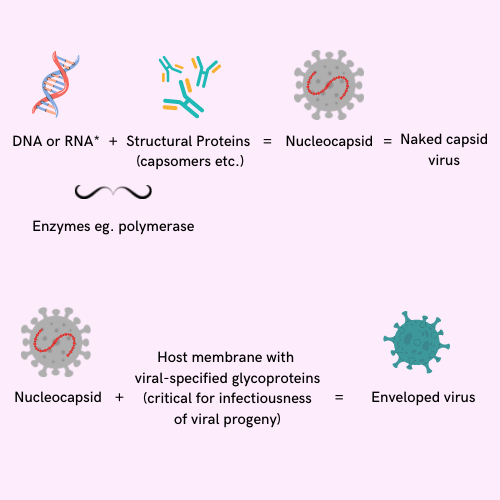
There are different types of viral replication. Each family has their own characteristics and much of it lies in the different nuclear material and encapsulation that the virus carries. But a few general notes that can be remembered are –
- Attachment– Every viral attachment is specific to the receptor present on the host cell. Eg – Rabies target cells are neurons and the receptor that it attaches itself to is the acetylcholine receptor.For HIV – The structural gene for it is Env producing gp120 that is the glycoprotein spike on the surface of HIV. This surface proteins have to bind to CD4+ and CCR5 (macrophages) or CXCR4 (T cells) to cause infection. If the CCR5 gene in host macrophages were mutated to not produce CCR5, the virus would not be able to attach itself to the macrophages to cause infection. Therefore, this gene has proven to make patients immune to HIV if homozygous; or cause slow progression to AIDS if heterozygous. This mutation is known as CCR5-Delta 32 and is prevalent in few, mostly in the European community, and is said to have risen from the Viking invasion. It maybe even traced back to the Bubonic plague being the cause of such mutation.
- Penetration
- Uncoating causes the release of nucleic acid in the cells
- Protein synthesis: Transcription ~ translation ~ Reverse Transcription
- Post-translational modifications.
- Assembly – just like the one every morning in school.
- And lastly, Release. It could be either by budding where the virus uses the host’s nuclear membrane or by cell membrane to be encapsulated/lysed (mostly seen in naked viruses).
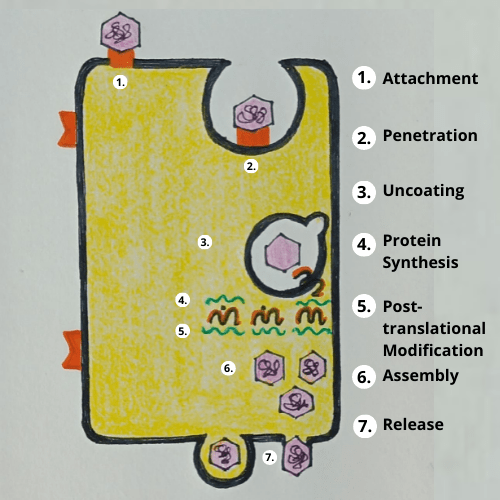
Another interesting example is of the Herpes virus where it is released by Syncytia formation. Viruses are released by exocytosis within cells. Here, they break out of the membrane adjunct to the consecutive cells instead of breaking out from the apical cell membrane. This causes multiple cell fusion, also seen in SARS-COV2.
Now that we have covered the basics let’s try to understand antigenic shift and drift – The most important virus to be mentioned here is from the family Orthomyxoviridae – Influenza virus. The nucleic acid of this virus is segmented (8). Point Mutations in the HA or NA gene results in a new influenza strain of the same type. This gives rise to a epidemic, and is known as Antigenic drift. When the segments are rearranged due to different strains of influenza attacking the same host cell, it gives rise to a new agent to which the population has no immunity i.e. a pandemic. This is known as the Antigenic shift. It is quite sudden and unpredictable.
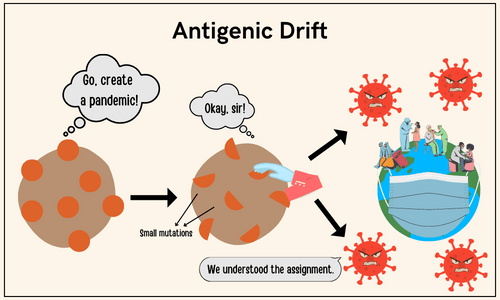
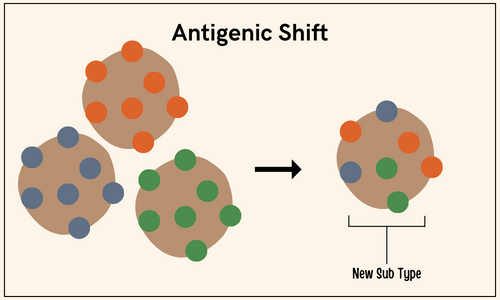
In the past few months, I was lucky enough to experience a wide array of viral infections, starting with the most infamous – Rhinovirus/common cold. Well, recovering from a common cold is quite easy and the medication involved is not rather special either. “Why?”, you may ask. There are over a 100 serotypes of rhinovirus that can affect humans. However, we rarely get infected by the same serotype. As in my case, the recovery was smooth. Unfortunately, I was not ready for what was about to hit me next. What seemed like a case of food poisoning turned out to be one of the most horrendous experiences that I have had. For some who have been through it, it may seem normal, even regular, but due to early misdiagnosis and late testing, the severity of the infection grew. Here are a few clues – Abdominal pain, nausea, extreme body pain and very high rise in fever, especially at night. After getting tested, the recovery was slightly slow but well paced. However, the after effects against my immunity are still persistent. It took 3 months for me to completely recover. Throughout this journey, I learned that there are 4 strains of this virus – DENV 1-4. Infection by the same strain causes less complications of the disease, but infection by different strains causes increased complications even though antibodies for the first remain. These prior formed antibodies react violently with the different strains.
Another fact – the virus directly attacks bone marrow and not platelets. This causes our body to treat our platelets as antigens, subsequently engaging in a sad play of self-destruction. Brownie points to the ones who guessed the virus – Covid-19! From what felt like a sore throat, it went on to be a stuffy nose and resulted into continuous body pain. What worried everyone the most was fatigue. For me, the major setback was the previously contracted viral infection, but nothing can stand in front of our passed down recipes of Kadha and Vitamin C + Zinc!
Even though I feel better now, the after effects of weight loss, fatigue and body pain remain. DENV also bears with it a few weird side affects. Brain fog and major hair loss was something that I was found quite interesting. DENV directly attacks the human hair follicle – dermal papilla cells, while Covid-19 affects the resting state of hair cells (telogen state). This is known as Telogen Effluvium, typically lasting for 2-6 months. Personally, the past 6 months were rough, but the amount of ‘viral knowledge’ that I gained is surely worth the pain! I guess it is true when they say – You do learn from your experiences!
References:
- https://healthcare.utah.edu/healthfeed/postings/2022/03/hair-loss-covid19.php
- https://www.frontiersin.org/articles/10.3389/fimmu.2021.816515/full
- https://elifesciences.org/articles/65962
- https://www.ncbi.nlm.nih.gov/books/NBK8611/
. . .
Writer
Aditi Kulkarni
Illustrator
Urja Kuber
Editor
Tejas Nimkar

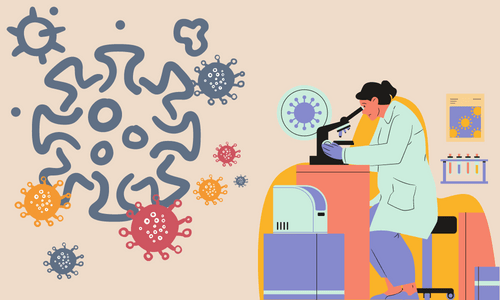
Very nicely written, with great illustrations!